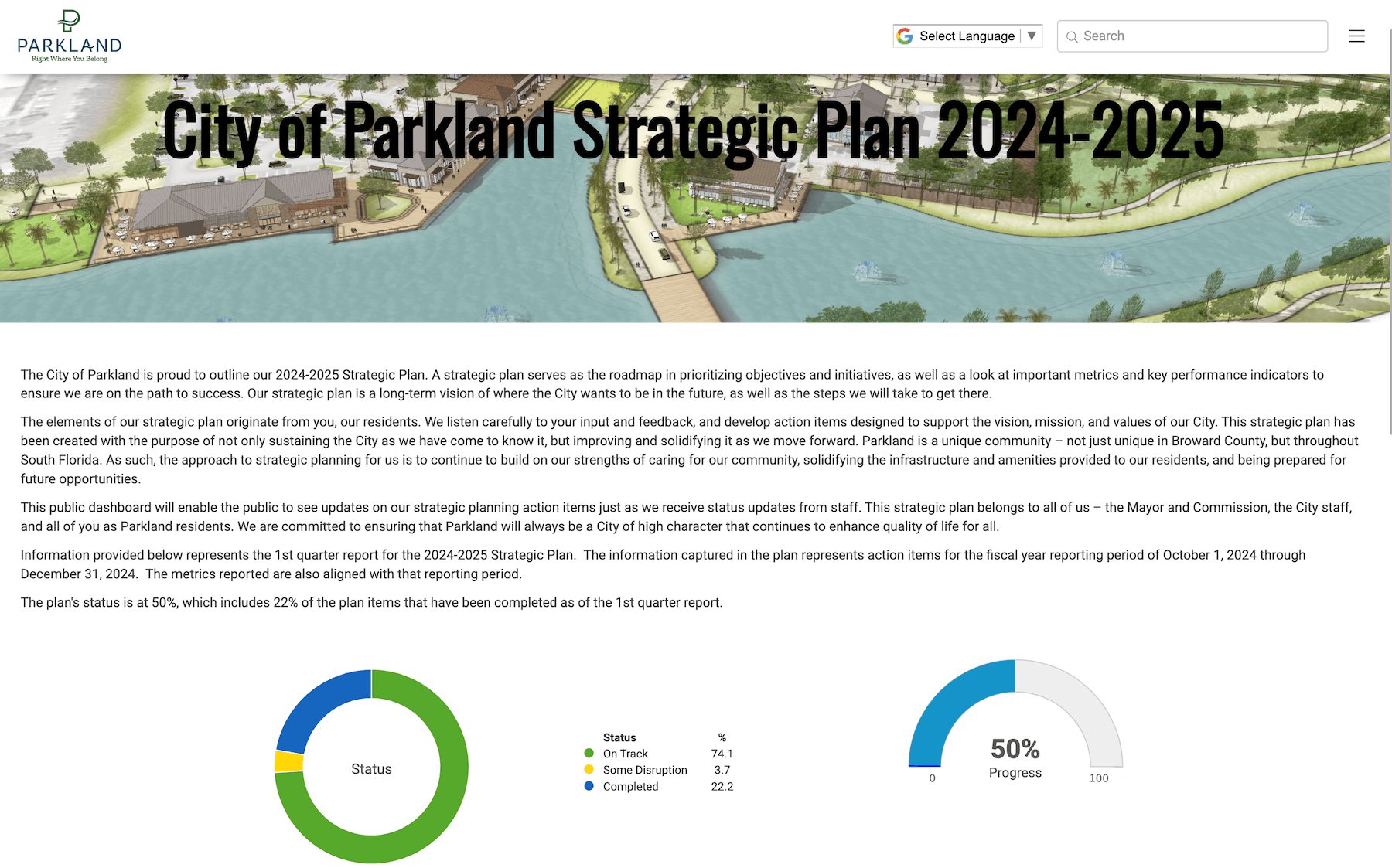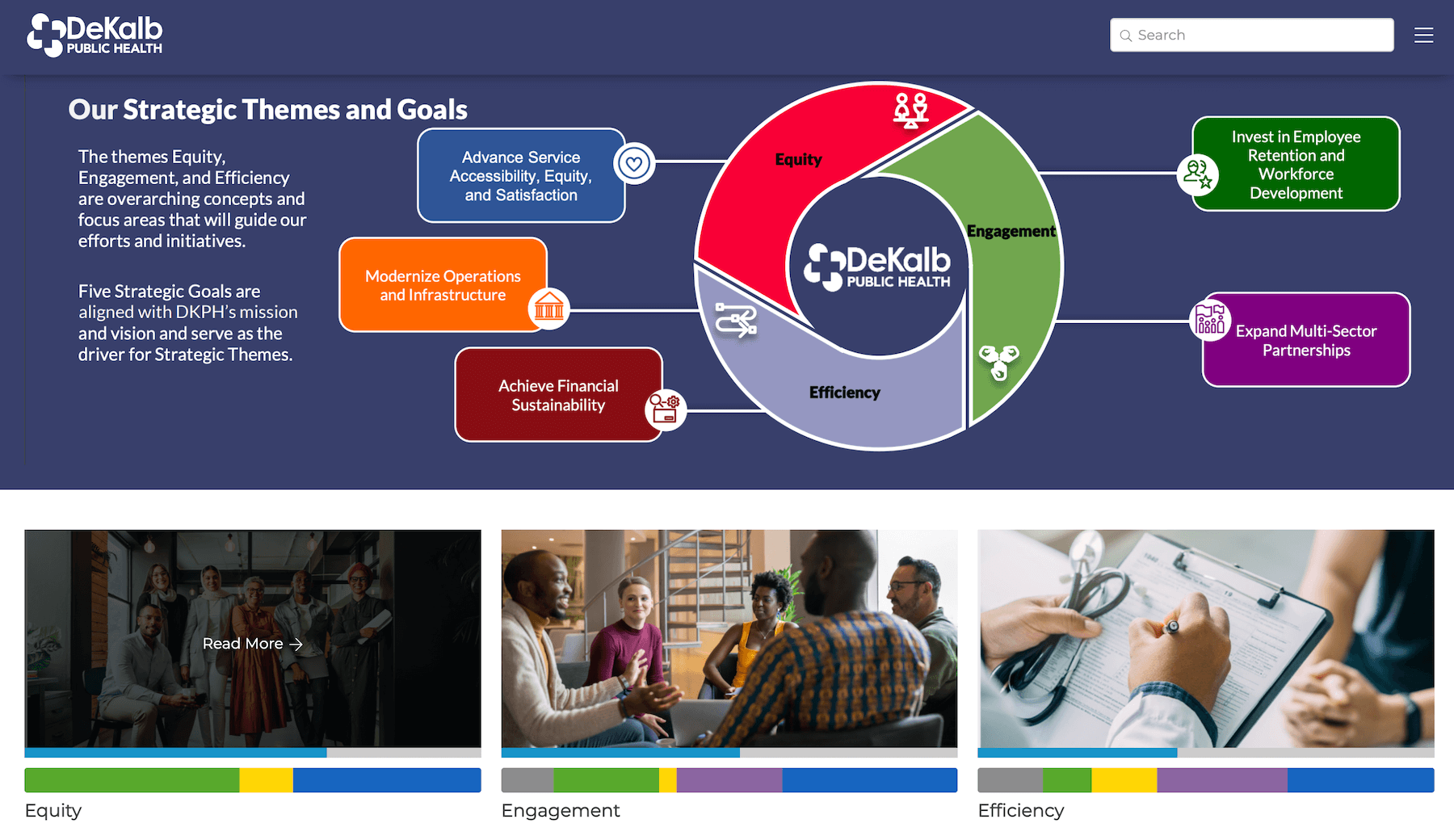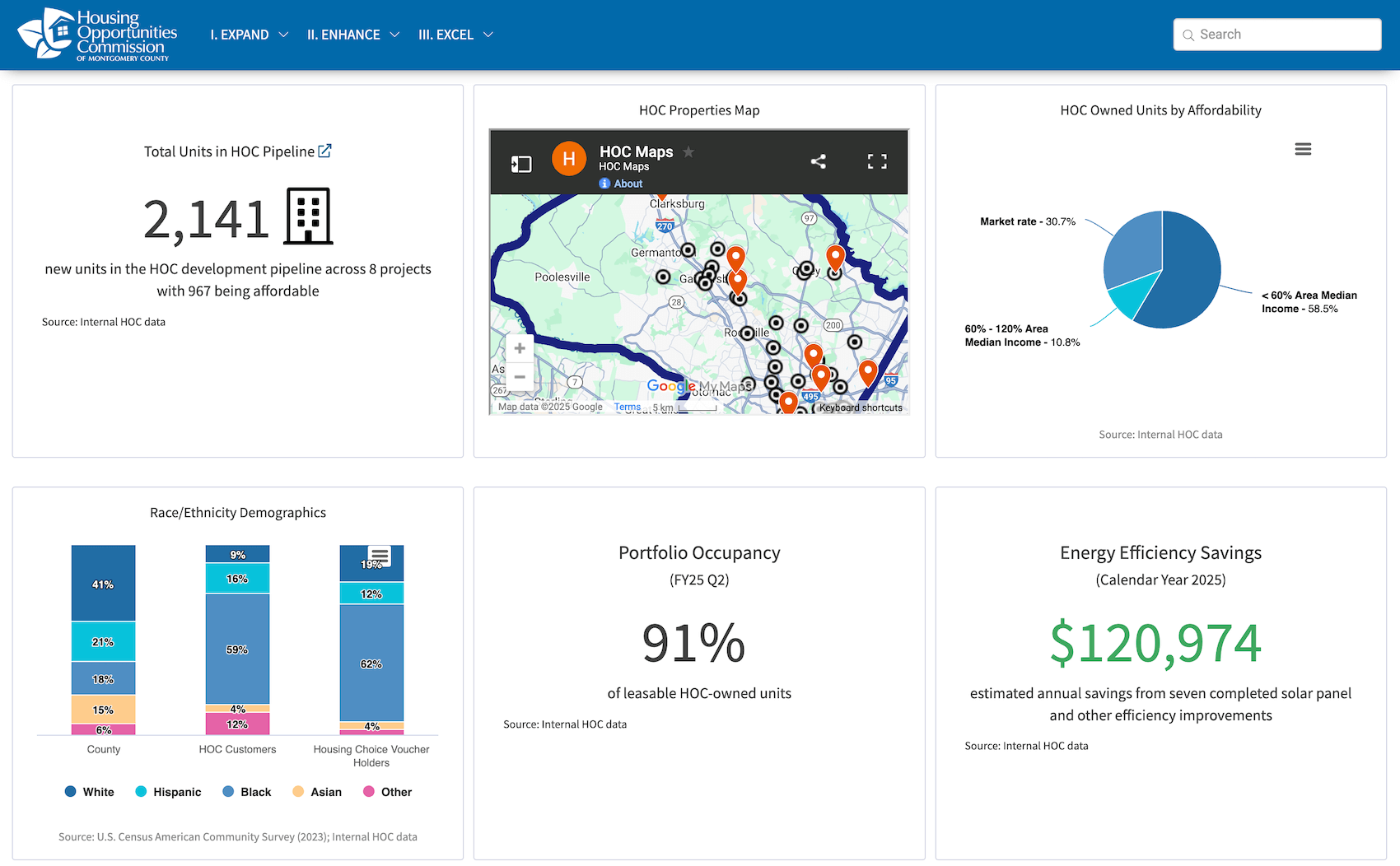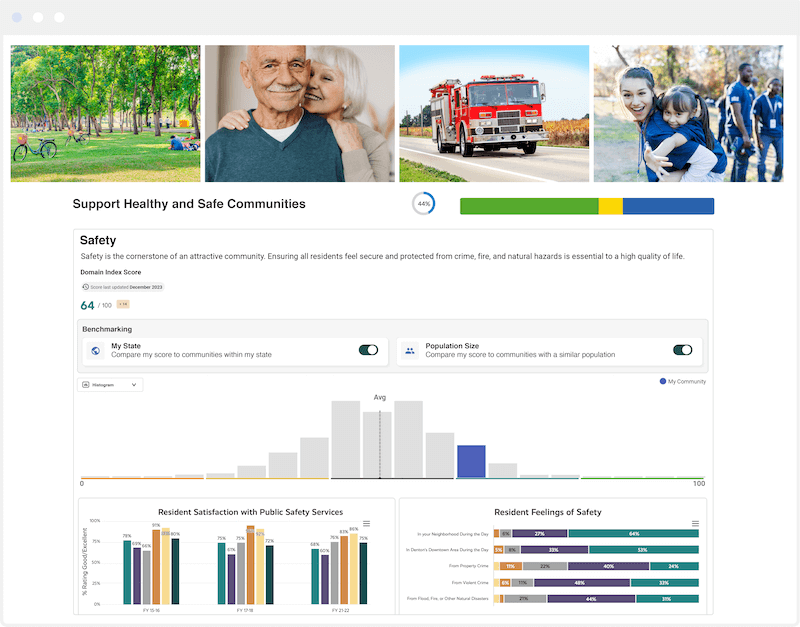Contents
- Portland Public Schools, OR: Embedding climate justice in facilities planning
- City of Parkland, FL: Delivering capital projects through measured execution
- DeKalb Public Health, GA: Modernizing access to essential public health services
- Housing Opportunities Commission (HOC) of Montgomery County, MD: Advancing equity through measured affordable housing solutions
- Town of Frederick, CO: Modernizing development codes for balanced and community-centred growth
- Performance measurement drives strategic outcomes
- ↓ Book a demo and deliver on your own strategic outcomes!
High-performing public agencies are our favorite thing!
Welcome back to our outcomes series, where we show what’s possible when performance measurement is used as a foundation for strategic management.
In this post, we’ll explore how different public sector organizations are translating data into action—from delivering on climate resilience in public schools to expanding access to affordable housing, improving public health infrastructure, and managing community growth through thoughtful local government planning.
These success stories are worth celebrating because they represent measurable progress, disciplined implementation, and a commitment to community outcomes. By focusing on the right metrics and using data to drive decision-making, these organizations have fully executed key priorities in their strategic plans.
Here’s a look at recent completed strategic outcomes.
Portland Public Schools, OR: Embedding climate justice in facilities planning
While the conversation around climate change often focuses on individual responsibility, we are seeing many more public institutions—including school districts—starting to implement climate action plans.
Public schools, in particular, sit at the intersection of climate risk and community resilience. Yes, they are spaces of learning, but they also serve as community hubs, and sometimes even emergency shelters, and therefore should be seen and treated as essential infrastructure. With buildings, buses, and other operations contributing to emissions (and with students and staff directly impacted by climate-related events) climate resilience planning is critical.
Schools have the power to protect vulnerable populations and ensure that facilities can withstand and respond to extreme weather events. A climate action plan makes change feel both possible and actionable—showing how public institutions can lead by example.
Portland Public Schools (PPS) has completed a major step in advancing its Climate Crisis Response Policy.
The district finalized and adopted an updated Long-Range Facility Plan, which integrates climate justice, resilience, and accessibility priorities directly into facilities planning and capital investments. Read more about it here.
This plan, shaped by comprehensive community engagement, now guides all future facilities decisions with a focus on:
- Educational program requirements
- Enrolment and capacity
- Facility condition
- Climate risks and resilience
- Prioritization of frontline communities and students with disabilities
The completion of this project reflects how PPS used performance measurement to move from strategic vision to implementation. Data and analysis were central to identifying facility needs, planning for resilience, and ensuring alignment with the district’s broader goals on climate justice and equity.
With the Long-Range Facility Plan completed and operationalized, PPS is now positioned to systematically update facilities district-wide and ensure that every capital project supports climate action and equity outcomes.
We’re really looking forward to seeing how PPS continues to lead with data-driven climate action and resilience for its students and communities.
City of Parkland, FL: Delivering capital projects through measured execution
Performance measurement is especially critical when cities invest in high-priority infrastructure. Capital improvement projects, plans, and large infrastructure changes carry heavy financial, operational, and community expectations. Without strong performance data and oversight, projects risk delays, cost overruns, or failing to meet community needs.
Located in northern Broward County, Florida, Parkland is known for its thoughtful planning, distinctive character, and strong commitment to community-centered infrastructure. As part of its 2024–2025 Strategic Plan, the City has recently completed two major capital improvement projects:
- The Hillsboro Boulevard/Everglades Way Roundabout
- The Loxahatchee Road Roundabout and Landscaping
These projects enhance mobility, improve traffic safety, and reinforce Parkland’s commitment to infrastructure that meets community needs while preserving their unique character.
Parkland’s success illustrates how integrating performance metrics—such as project scheduling, budget adherence, and community impact—results in timely, high-quality infrastructure that directly benefits residents.
With these upgrades complete, we’re excited to see how Parkland continues to advance its infrastructure and quality of life goals!
DeKalb Public Health, GA: Modernizing access to essential public health services
In public health, access is often the first and most important determinant of outcomes.
DeKalb Public Health (DKPH) has been serving the residents of DeKalb County for over a century, providing essential services that go well beyond clinical care.
With programs ranging from disease prevention and maternal health to refugee health, family planning, HIV/AIDS services, and chronic disease management, DKPH plays a central role in protecting and promoting community health. The agency also operates vital community-based initiatives, including youth development, men’s health programs, environmental health efforts, and nutrition services.
By the end of 2024, DKPH had achieved full completion of a key strategic initiative: a comprehensive website redesign focused on accessibility, equity, and user experience. The updates included:
- A fully reorganized and simplified service directory
- Enhanced multilingual functionality to serve DeKalb’s diverse population
- A formalized customer feedback system to ensure continuous improvement
Performance measurement played a pivotal role in this work by identifying critical gaps in access, navigation, and language inclusion.
The agency used data from web analytics, community feedback, and operational assessments to prioritize and execute improvements that directly aligned with community needs. This project directly enhances how residents access life-saving health information and services, particularly those who are most vulnerable.
With so many services, DKPH needs to continuously monitor how effectively it reaches and serves its population. From tracking vaccination rates in at-risk groups to reducing emergency room wait times, performance data helps public health agencies ensure that resources are used effectively, inequities are addressed, and lives are improved.
DKPH’s website redesign marks a significant step forward in making the agency’s broad range of clinical and community health programs easier to access, especially for residents who have historically faced barriers to care.
We’re looking forward to seeing how DKPH continues to strengthen health equity through community-centered performance management.
Housing Opportunities Commission (HOC) of Montgomery County, MD: Advancing equity through measured affordable housing solutions
Affordable housing challenges are complex and urgent. Rising housing costs, limited supply, and persistent inequities require agencies like HOC to make the most of every dollar, every program, and every initiative. Performance measurement helps cut through this complexity.
The Housing Opportunities Commission (HOC) of Montgomery County is a vital force in providing safe, affordable, and high-quality housing to low- and moderate-income residents. Beyond housing, HOC offers supportive services designed to strengthen families, foster economic mobility, and improve quality of life—making the organization a key player in addressing housing affordability and social equity in the region.
By the end of 2024, HOC completed several important projects aimed at improving the resident experience:
- A fully updated Customer Resource Guide now available in both print and online formats
- Installation of digital displays across reception areas to enhance communication and accessibility
- Enhanced multilingual content on the HOC website, making essential services more accessible to Montgomery County’s diverse population
HOC’s dashboards and KPIs monitor affordable housing development, rental assistance, resident support services, and even energy efficiency efforts. This data enables leadership to identify what is working, address gaps quickly, and remain accountable to both residents and community partners.
We’re looking forward to seeing how HOC continues to lead by example in the affordable housing sector, using performance data to turn strategy into lasting impact.
Town of Frederick, CO: Modernizing development codes for balanced and community-centred growth
In a community where population growth and development pressures are accelerating, strategic planning is a real balancing act between modernization and character preservation. Rapid growth risks overwhelming infrastructure, eroding quality of life, and losing touch with community identity. We see this tension often in smaller towns and communities that are managing expansion. So much of their allure and draw is a particular characteristic, and unfortunately, when that isn’t protected, it can be eroded quickly.
On the other hand, you have to navigate without being too myopic. Too close-minded to change or innovation. Again: it’s a balancing act.
Nestled on Colorado’s Front Range, the Town of Frederick has grown into one of the region’s fastest-growing and most community-oriented small towns. While retaining its deep roots as a historic mining town, Frederick today is a thriving hub of family life, recreation, and small-town charm, all within reach of the Denver metro area.
As part of its 2024–2025 Strategic Plan, Frederick recently successfully completed two critical updates to its Land Use Code:
- A streamlined Planned Unit Development (PUD) process to facilitate well-managed, large-scale development
- New Residential Protection Standards to safeguard community character with improved landscaping, setbacks, and neighborhood buffers
Frederick used performance measurement to guide this process—tracking timelines, regulatory alignment, stakeholder input, and capacity considerations to ensure these updates reflect resident priorities and long-term sustainability.
By measuring not just the quantity but the quality of growth, Frederick can:
- Attract businesses and amenities that support a vibrant economy
- Protect open space, parks, and natural assets
- Support housing and infrastructure development that meets community needs without compromising character
- Build trust by clearly demonstrating progress to residents
Frederick’s strategic focus on Community and Economic Vitality is strengthened by its use of performance dashboards to track capital projects, economic development initiatives, and community engagement efforts.
Whether implementing the Frederick Recreation Area Master Plan, revitalizing the historic downtown, or expanding retail and dining options, the Frederick team ensures each project is guided by measurable strategic outcomes and transparent reporting.
By completing these Land Use Code updates, Frederick has laid the groundwork for community-centred, sustainable growth. The town’s ability to align performance measurement with economic development ensures that as Frederick grows, it remains a place where residents actively shape and enjoy the life they’ve built together.
We’re excited to see how Frederick continues to strengthen its capacity for economic vitality, community engagement, and sustainable development.
Performance measurement drives strategic outcomes
These organizations are demonstrating that strategic outcomes aren’t achieved by intention alone—they are delivered through performance measurement, disciplined management, and community engagement. Each completed milestone serves as proof that clear measurement leads to meaningful action and lasting community benefit.
We can’t wait to see what they do next.









